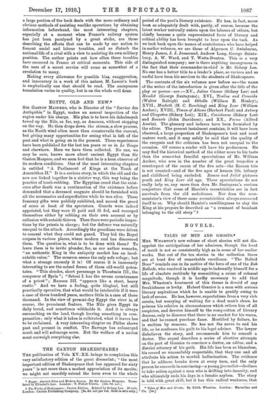THE CAXTON SHA.KESPEARE.f
THE publication of Vols. XV.-XX. brings to completion this very satisfactory edition of the great dramatist ; "the most important edition of Shakespeare that has appeared for sixty years" is not more than a modest appreciation of its merits; we might not unsafely extend the term even to the whole • RgUt: Ancient Sites and Modern Scenes. By Sir Gaston Maspero. Trans- lated by Elizabeth Lee. London : T. Fisher Unwin. 1128. 6d. net.] t The Works of Shakespeare: CarlostEdition. Edited by Sidney Lee. 20 vols. London: Caxton Publishing Company. [6s. 6d. net per vol. Sold in sets only.)
period of the poet's literary existence. He has, in feet, never heel so adequately dealt with, partly, of course, because the latest worker naturally enters upon the labours of others, but chiefly because a quite unprecedented force of literary and critical ability has been brought to bear upon the task. As we look back upon the names of contributors who have helped in earlier volumes, we see those of Algernon C. Swinburne, Henry James, J. J. Jusserand, Andrew Lang, George Saints- bury, A. W. Ward, and T. Watts-Dunton. This is a very distinguished company; nor is there anything incongruous in the fact that their commander-in-chief is Mr. Sidney Lee. No one has a better title to a leader's place, so various and so useful have been his services to the students of Shakespeare.
The contents of the six volumes now before us—the name of the writer of the introduction is given after the title of the play or poems—are :—XV., Julius Caesar (Sidney Lee) and Hamlet (George Santa3rana); XVI., Troilus and Cressida (Walter Raleigh) and Othello (William E. Henley); XVII., Macbeth (H. C. Beeching) and King Lear (William Archer); XVIII., Tim on of Athens (Herbert Paul) and Antony and Cleopatra (Sidney Lee); XIX., Coriolanus (Sidney Lee) and Sonnets (John Davidson); and XX., Poems (Alfred Austin). The glossary and indexes have been furnished by the editor. The present instalment contains, it will have been observed, a large proportion of Shakespeare's best and most mature work, and it may safely be said that the quality of the exegesis and the criticism has been not unequal to the occasion. Of course a reader will have his preferences. He may find the historical method of the editor more to his taste than the somewhat fanciful speculations of Mr. William Archer, who sees in the number of the great tragedies a counterpart of the canon of the five acts—the Roman trio is not counted—and of the five ages of human life, infancy and childhood being excluded. Romeo and Juliet pictures youth and King Lear old age. These speculations do not really help us, any more than does Mr. Santayana's curious conjecture that some of Hamlet's eccentricities are in fact survivals from the old melodrama. Nor does the com- mentator's view of these same eccentricities always commend itself to us. Why should Hamlet's unwillingness to slay the King at his prayers be described as "a remnant of bombast belonging to the old story" ?






















































 Previous page
Previous page